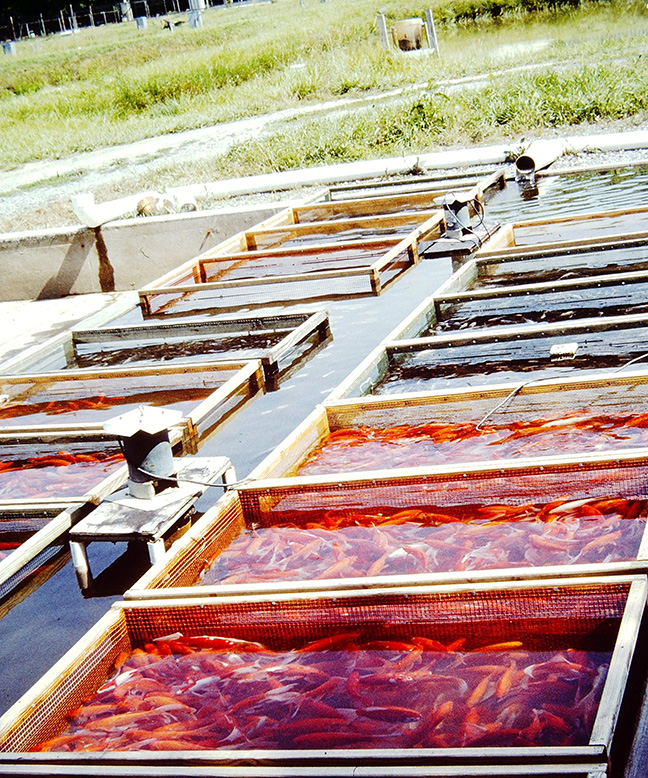Frederick County’s Golden Immigrants
by James Rada, Jr.
Note: This is part three of a series about goldfish farming in Frederick County.
In the early 1900s, goldfish farming produced a major cash crop in Frederick County.
“By 1920, Frederick County was producing 80 percent of the goldfish in the United States, and they were being shipped from Thurmont to all parts of the country,” George Wireman wrote in his book Thurmont: Gateway to the Mountains.
His number is supported with information in “The News-Post Year Book and Almanac.” Throughout the 1930s and into the 1940s, the annual publications note that Frederick County had “more goldfish produced than in any part of the United States.” Interestingly, the yearbooks list goldfish as “selected crops harvested” rather than “livestock on farms.”
The fish raised in Frederick County were considered common goldfish. A 1914 The Frederick News article noted, “Few, if any, of the Japanese variety are raised. They are said to be too clumsy and awkward and an easy mark for preying birds. No coloring is necessary for the fish raised here, as is the case with those raised in some localities, where the fish have to be kept in shallow ponds in order to obtain their color.”
By the late 1930s, competition from larger, more diversified, growers across the country reduced the demand from Frederick County farms. Ernest Tresselt, whose family raised goldfish in the Thurmont area said, “Frederick County farmers raised the plain, common goldfish. By the 20s and early 30s, fancier varieties became available. It wasn’t so easy for locals to keep up with the change. They weren’t in a position to grow fancier varieties that were genetically difficult to breed, and we lost some goldfish producers.”
Tresselt said that when he entered the family goldfish farming business, about 40 percent of each year’s crop would not turn orange. They remained the dull, muddy color of wild goldfish.
“Those fish would be sold as bait fish. They were called Baltimore minnows,” Tresselt said.
He said the county’s goldfish breeders began more selective breeding of goldfish and the percentage of goldfish that turned the proper color dramatically increased and “Baltimore minnows” disappeared.
The use of modern science helped the goldfish farmers increase their harvests and profitability, which helped keep the county goldfish farmers competitive.
Other advances worked against county goldfish farmers. Advances in shipping techniques and the increased variety and quality of goldfish available from growers around the world gradually changed the goldfish market. The result was that farms producing only common goldfish seasonally could not compete. By the 1940s only a few farms in Frederick County were still cultivating goldfish.
By the 1950s, fish could be shipped in plastic bags by air freight. The plastic made shipping costs cheaper and the planes extended the distance the goldfish could be shipped. This increased the competition in the market, particularly from the countries in the Orient that had created goldfish.
“Everything changed,” Tresselt said. “We have to supply fish year-round. The competition made it unprofitable for most farmers and they went out of business.”
Charles Thomas, another Frederick County goldfish farmer, said that with air transportation, areas that usually weren’t thought of as places for goldfish farming, such as Arkansas, became competitive or even better locations than Frederick.
“By going south, you had a longer growing season,” said Thomas. “In a place like Arkansas, instead of having only one crop each season, you could have two.”
By 1980, Lilypons, once the world’s largest producer of goldfish, had diversified so that it now specialized more in water garden supplies and plants than fish. Hunting Creek Fisheries and Eaton Fisheries also survived by diversifying their offerings into plants, game fish, and/or other types of ornamental fish, such as koi.
Today, you can still see fish ponds marked on a Frederick County maps, but not as many as there once were.
Lilypons has 265 acres and about 500 ponds, though very few of them are devoted to goldfish. However, the business has grown into a multi-million-dollar business employing more than 50 people.
Hunting Creek Fisheries still has ponds in Thurmont and Lewistown. Eaton Fisheries still has its Lewistown ponds as well. Other ponds are now lost to history:
The Claybaugh fish ponds are now covered over by Mountain Gate Exxon and McDonalds in Thurmont.
Along Moser Road across Hunting Creek from the Thurmont sewage treatment plant is where Ernest Powell and Maurice Albaugh used to have fish ponds.
Ross Firor used to have his fish ponds east of the Maple Run Golf Course.
The ponds on William Powell’s Arrowhead Farms on Apples Church Road north of Thurmont were adjacent to Owens Creek have been turned into pasture.
Frank Rice’s goldfish ponds south of Thurmont alongside Route 15 have been filled in and turned back to pasture.
Frederick County’s no longer the biggest producer of goldfish in the country, but there are still fish ponds out there, and if you stop and watch, you may see a flash of gold.

Goldfish in vats at the Hunting Creek Fisheries in the late 1980s.

